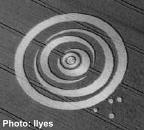 |
| Second crop formation found near Fosston, MN on July 27, 2008.
Photo: Dean Vikan
|
There was apparently very little crop circle activity in the U.S. in 2008, with only a scattering of "randomly-downed" events and another few obviously man-made impressions reported over the summer. Perhaps the most interesting U.S. reports BLT received were of two circle formations found within 10 miles of Fosston, Minnesota the first on July 25th, the second on July 27th, both in wheat fields.
Of the two it was the second one which proved to be the more interesting, based on the ground field examination of the plants and on anecdotal information later supplied by a respected local resident and reporter for the local 13 Towns Newspaper, Dean Vikan.
Although the initial impression of BLT's fieldworker Brad Jenson, based on his field examination of the plants and lay details, was that both Fosston formations were man-made, several factors later emerged which may complicate that conclusion, particularly in regards to the second event.
 |
|
First formation found near Fosston, MN – found July 25, 2008.
Photo: Dean Vikan |
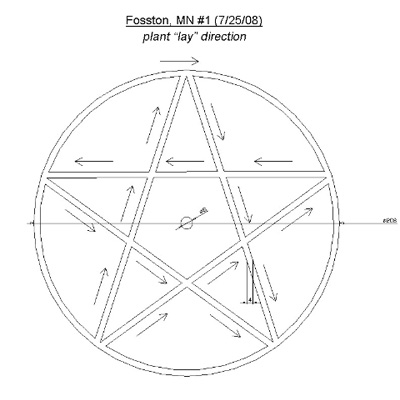 |
| BLT fieldworker Brad Jenson's diagram showing direction of
plant "lay" in Fosston #1. Center circle (8' diam.)
& outer ring both laid clockwise. |
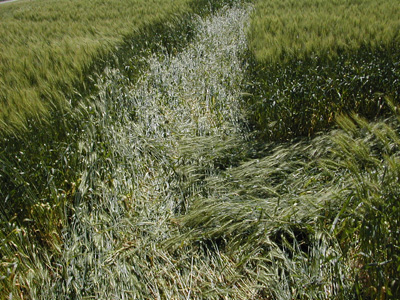 |
| Intersection of one of the internal pathways wiith exterior ring; all pathways
in "star" & the external ring were 4 ft. wide. Photo: Brad Jenson |
The landowner's son, Anthony Tronerud, lives in a house overlooking the field in which the "star" formation was found on July 25th. The night before it was discovered he was watching TV until about 2am, but saw no activity out in the field which he thinks he would have noticed. He did see an unfamiliar silver-colored vehicle sitting on the nearby road on the afternoon of July 24th, but has no idea whether it had any connection to the crop circle.
Brad Jenson's field examination on July 29th indicates that the outer ring of this formation was laid down first, the internal "star" design afterward. Jenson measured the distance from the center of the 8'-diameter center circle to the outside edge of the ring to be exactly 100 ft., and all the pathways and external ring to be 4 ft. wide. He also pointed out that this formation was on "slightly hilly" terrain and that he was unable to see the entire formation from any one point inside it.
This observation could account for the fact that most of the pathways that make up the "star" were not straight and, along with the additional fact that the 4 ft. width of the pathways was exactly half the diameter of the center circle--also heightens suspicion that a 4' wide plank was used in the construction. Jenson found no apical node (top node, beneath seedhead) elongation or expulsion cavities (holes blown out in the lower stem nodes), but did see apical node bending of about 30 degrees, related possibly to natural recovery processes known to occur in plants which were quite green and still growing when flattened.
If still-green plants are flattened (but not broken at the base) they will continue to grow, attempting to reorient themselves to sunlight and gravity which produces bending at the plant stem nodes. Mr. Jenson's discovery of 30-degree apical node bending 5 days after the "star" was apparently formed is at the upper edge of node-bending found in control studies of still-growing crop mechanically flattened this late in their growth cycle.
No magnetic particles were found in the soils when a "magnet drag" was conducted around the ring which encircled the "star".
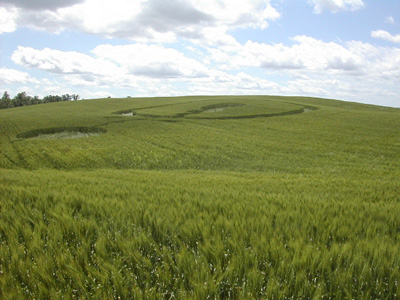 |
| 2nd formation near Fosston, MN as it appeared on Sunday, July 27, 2008
Photo: Lori Paulson |
At 7am on Sunday, July 27th (two days after the "star" formation was found) a second crop circle a "pictogram" style made up of multiple circles and pathways and two rings was found by Dean Sorgaard in one of his wheat fields on his way to church. This second formation was more complex in overall design and larger than the first and also, because of its placement next to a well-used road, much more visited by the public.
Several residents in the nearest houses to this field reported they heard dogs barking "like crazy" between 2-4 am Sunday morning, as well as cattle braying in the middle of the night, an observation which is of interest because animal disturbance is often reported in conjunction with new crop circles forming. And, since some animals are known to have more sensitive hearing than people and are also known to respond to various electromagnetic wave-lengths more readily than people, it is possible that unusual animal behavior may provide a clue to the causative agency involved in forming crop circles.
 |
| Diagram of Fosston #2 as it appeared originally. Circles were all laid
counter-clockwise; narrow 1'-wide perimeter ring & larger
8'-wide inside ring were laid clockwise.
Diagram by Jenson, to scale. |
BLT fieldworker Brad Jenson added these details. The large standing ring was 11 ft. wide and the inner standing circle was 88 ft. in diameter. The pathway from the first (24') circle at the bottom was 25 ft. long and the pathway from the second circle (27') up to the 1 ft. wide perimeter ring was 24.5 ft. long. The centers of the circles appeared to be in their "geometric" centers and Brad could see no holes, although by the time he visited the site these centers had been somewhat trampled, which could have occluded holes which may have been present.
He further noted that, overall, the circles were not totally circular, but instead were actually elliptical. In many previous cases in which circular components of formations have occurred on hillsides we have found that, when measured on the ground, these circles are in fact ellipses. In all other cases we have measured the ellipse will extend up-and-down the hill (with the degree of ellipse equal to the slope fo the hill), not across it as is the case here.
 |
| Although "rougher" than is often the case, the counter-clockwise partially-
flattened lay in this circle is not totally atypical. Photo: Dean Vikan |
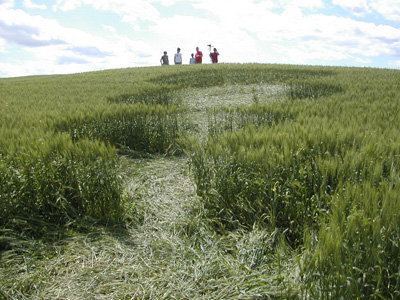 |
| 4 flattened circles inside standing center circle show elliptical shape
running across hillside. Photo: Brad Jenson.
|
 |
| Very rough clockwise lay in 8 ft.-wide section of larger ring coming down
the hill, which looks like the result of two separate passes
with a 4 ft.-wide plank. Photo: Brad Jenson |
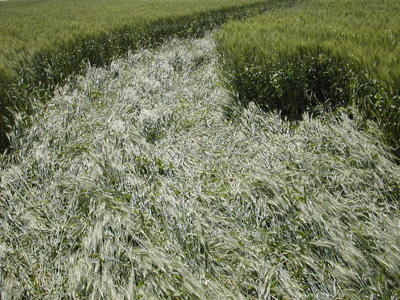 |
| The other side of the same ring where it widens to 12 ft. as it goes back up
the hill, suggesting an aborted attempt to widen the ring
to 12 ft. overall. Photo: Brad Jenson |
The visual impact of the very rough lay generally and, particularly, this section of the outer ring where it appears that a 4 ft.-wide plank or board was beginning an attempt to widen the ring to a 12 ft. width overall, immediately struck our fieldworker as evidence of mechanical construction of this formation. Mr. Jenson also noted some signs of stress on the plants in the form of splitting and/or fraying in some places the sort of damage we know can be caused by direct mechanical abrasion. In addition, the fact that some of the circle diameters suggest the use of a 4 ft.-wide board further strengthened this impression.
However, other details perhaps argue against this conclusion. We know from previous research that "rough" or "messy" plant lays are not necessarily a sign of manmade circles in fact, in the U.S. and also in Canada, many authentic circles have exhibited this sort of lay. And Brad's examination of the plant bases along the edges of flattened areas (where people had not already obliterated the available evidence) did not show the sort of breakage that is usually associated with mechanical "pranks with planks" construction the bases of these plants were not crushed.
However, the wheat in this formation was green (approximately 3 weeks from harvest, according to the farmer), and was therefore more pliant than dried-down plants closer to harvest would be and, so, it's possible that the stems might not break at the base when flattened by mechanical means or some other, unknown, process.
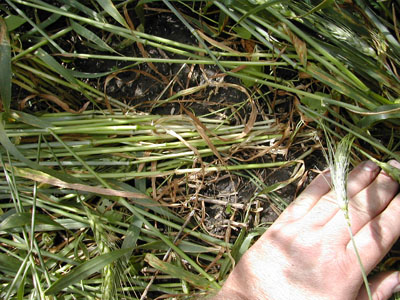 |
| Plant bases along the perimeters of downed areas were not crushed, as
they often are from mechanical flattening.
Photo: Brad Jenson. |
The most significant change documented in crop circle plants which indicates a non-mechanical creation is elongation (stretching) of the apical (top) node. In several hundred crop formations which have been carefully sampled and then examined in the lab, this elongation of the apical node has been found to be statistically significant relative to the controls. If the causative agency for node elongation is microwave radiation (as has been hypothesized in three peer-reviewed scientific papers published in 1994, 1995 and 1999 http://www.bltresearch.com/published.php), the plant's internal moisture is being briefly and intensely heated, turning it to steam. Because the plant fiber at the top of the plant stem is younger and more elastic than are the fibers lower down the stem, the steam is able to seep out, leaving permanently stretched apical nodes behind.
In some crop circles the apical node elongation is fairly subtle and not visually impressive, and can only be determined as significant (at the 95% level of confidence) after measuring hundreds of formation nodes and then statistically comparing those results with node measurements of hundreds of control plants.
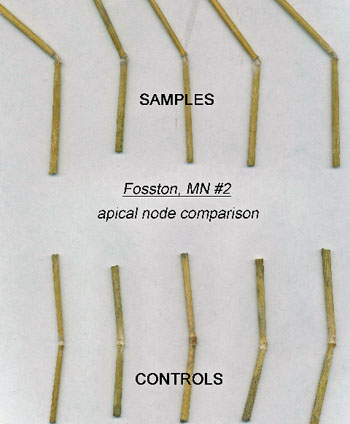 |
| Some apical (top) node elongation was found in dried samples.
Photo: Brad Jenson |
Although apical node elongation was not visually apparent in situ in this case, sample and control plants taken by Mr. Jenson and then dried down do contain some apical node elongation.
 |
| Approximately 30-degree bending at the apical (top) nodes, found in ring area
only 2 days after formation occurred. Photo: Brad Jenson |
Another plant change found in both Fosston formations is also of interest. The importance of bending of the plant stems at node points is often misunderstood, with many crop circle enthusiasts erroneously convinced that node bending is always significant. Control studies carried out by the BLT Research Team have clearly shown that node bending always occurs over time when young and still vigorously-growing plants are flattened, but not killed. Phototropism (the natural tendency of the plant to reorient itself to sunlight) and gravitropism (the plant's reorienting response to gravity) will begin to occur immediately once young plants are downed and, therefore, these natural forces must be ruled out before concluding that node bending in crop circle plants is meaningful.
From the control studies we know that even in young and vigorously growing wheat it takes about 5 days after flattening to produce significant bending at the nodes. Mr. Jenson reports here that he observed node bending in both Fosston formations of about 30 degrees but in Fosston #2 this was just 2 days after it had been flattened, a degree of bending at the absolute upper limit found in mature crop flattened in control studies. This crop was still green, but it was only 3 weeks away from harvest, by which time gravitropic and phototropic responses should be minimal.
Mr. Jenson also reports that he carried out a magnetic drag around the outer edges of some of the circles, but recovered no magnetic material with this effort. He also saw no evidence of expulsion cavities in the plant stems anywhere in the formation.
 |
| Missing seed-heads found on some of the standing plants scattered
throughout the 8 ft.-wide flattened ring.
Photo: Brad Jenson |
A final observation regarding the plants inside the formation was the discovery of missing seed-heads on 35-40 standing plants scattered throughout the 8 ft.-wide flattened ring. Jenson tried to remove seed-heads with his hands but found this "very difficult" to do on the green plants. He was, however, able to remove seed-heads easily by dragging the sharp edge of his shovel across plants when he pushed them down.
The missing seed-heads in the crop circle plants were discovered, however, on standing plants not on those that had been flattened.
And so we have very conflicting results to weigh in our attempts to discern the "authenticity" of this particular formation. Was it man-made or not? On first glance to an experienced eye the general "roughness" of the lay, the apparent attempt to add another 4 ft.-wide section to the 8 ft.-wide ring, the presence of circles which could easily reflect a 4 ft.-wide plank as the tool of choice, and the lack of visible apical node elongation and expulsion cavities all argue for a mechanical creation.
But the fact that the plant bases were not crushed, that there does appear to be some apical node change in the dried plant samples, as well as the presence of the 30-degree node bending just 2 days after the formation appeared argue against mechanical flattening.
Two other findings the fact that the circles were actually ellipses in which the long diameter went across the hillside and the missing seed-heads on standing plants confuse the issue further. And the precision of the overall design, particularly in such a large formation on quite sloping land, also needs to be taken into consideration, particularly if we are thinking that local (and thus inexperienced) individuals made this particular crop circle.
And there are two more facts which cannot be ignored. At 3:46am on Saturday, July 26th just 27 hours prior to the discovery of the Fosston #2 formation--a respected local resident and reporter for the "The Thirteen Towns" newspaper had an experience not unlike many others reported to us over the years in conjunction with new crop circles forming. He had actually not remembered this event until a conversation he and I had on the phone, in which I described light columns I had witnessed some years ago in Holland http://www.bltresearch.com/eyewitness/eyewitness1.php. It was at the exact moment I was describing the light tubes I had seen that he suddently recalled his own experience of a few days earlier.
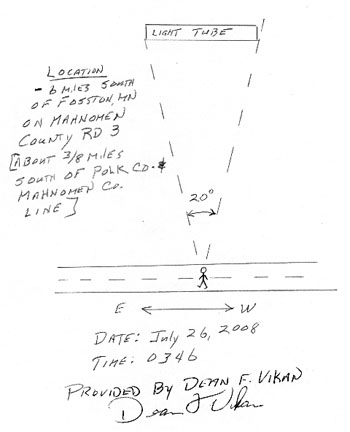 |
Dean Vikan habitually rises early and regularly takes a morning walk. On that Saturday he began his constitutional as always, walking along a road at the south end of Sand Hill Lake, about 10 miles away from the wheat field in which Dean Sorgaard would discover the second Fosston crop circle 27 hours later. It was "almost pitch-black" dark out and he walked with his eyes down in order to see where he was going. Suddenly the road surface in front of him lit up with a flash, the intensity of which was "almost as bright as a mercury arc yard-light at maybe a dozen yards away."
The illumination of the roadway lasted only a few seconds and Mr. Vikan then looked up, searching for clouds and thinking that what had just seen must have been an "extended lightning" event. At first he saw only stars in the sky until his gaze was directed almost straight up at which instant he saw a "cloudy, glowing white" tube-like light "like a partially-charged fluorescent light" almost directly overhead. It had a length-to-width radio of about 10:1 and the ends were "squared off," and overall it was "fatter" than a normal fluorescent light-tube would be.
The light object was oriented east/west and, although it was difficult for Mr. Vikan to estimate it's distance, he felt it was higher than one could reach, but nowhere near as far away as an airplane's contrail would be. He also felt that what he was looking at was a "fading" light source, since he had only discovered it after the ground illumination had faded. He looked away at one point and when he looked back the "tube" was still there, but he was unable to determine a "front" or "back" end of the object because both ends were squared off and the intensity of the light was the same at both ends. Although he had considered whether it was possible that the light was a meteor trail, he realized it was both much wider than a meteor trail would be and it was not moving. He had heard no sonic boom and reports there was no storm approaching and no "normal" lightning or clouds present. To the best of Mr. Vikan's recollection, after a few more seconds the light tube "just faded completely out" and he continued on with his walk.
What is most significant about Mr. Vikan's sighting from my point of view is the fact that he had totally forgotten the whole event and, I suspect, might not have recalled it at all had he not had the conversation with me a few days later about the light-columns I'd witnessed the night a new crop circle had occurred in Holland in 2001. I also think it is peculiar that 2 days after his morning encounter, when Vikan first heard about the Fosston crop circle a decidedly novel event in this town--he failed to recall the equally novel experience he'd just had himself, nor did he make any connection between the two.
If the BLT Research Team had a dollar for every time we've heard about anomalous aerial light phenomena in association with the appearance of new crop circles, we'd be a lot better funded than we are. Personally, I suspect Mr. Vikan's experience and the 2008 Fosston crop circles are probably related, although I don't know how.
A final note. Because our initial assessment that both of these Fosston formations were man-made, and also because of financial constraints, an in-depth sampling was not carried out. But after hearing of Dean Vikan's experience I asked our fieldworker Brad Jenson to return to the area and re-examine the circles.
On Saturday, August 2nd Jenson did return and to his surprise found that two new circles had been added to the second formation. We know these were not present on Thursday of that week because aerial photos taken on that day (July 31st) do not show the new circles but 2 days later the new 10 ft. diameter circles were definitely present, both centered on the thin 1 ft.-wide perimeter pathway.
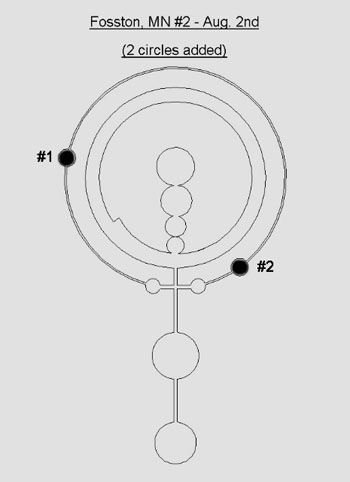 |
| Two 10 ft.-diameter circles are found to have been added
sometime between July 31 – Aug. 2nd.
|
Photographs of the new additions, taken by Lori Paulson, show a similar "messy" lay in the newly downed plants to those flattened in the earlier circles; the plants in the centers of the new circles were now quite brown from having been exposed to full sun and to people walking through the formation since July 27th.
 |
| Original 1 ft.-wide perimeter ring with one
of the two added circles.
Photo: Lori Paulson
|
 |
| One of the new 10' diameter circles, laid clockwise & centered on the original
1 ft.- wide perimeter ring. Photo: Lori Paulson
|
 |
| Fosston #2 with the two added circles; after only a week or so the crop is
drying down, indicating harvest not too far away.
Photo: Lori Paulson |
I wish we had been able to carry out a full sampling of both Fosston crop formations. If this had been done the node-length and seedling-growth results would almost certainly have provided data which would help clarify what actually happened here whether one, or both, of these formations were mechanically flattened by people with too much time on their hands, or whether, perhaps, something a bit more interesting took place.
At this point in time such in-depth laboratory examination of crop circle plants (and soils) is the only scientifically established method available to rule-out mechanical (planks or boards) flattening. Statistically significant apical node elongation, the presence of expulsion cavities, seedling-growth abnormalities, the presence of microscopic magnetic particles in the soils and their distribution characteristics and changes in crystalline structure of clay minerals in crop circle soils all of these factors considered together can determine whether circles have been created mechanically or not. [To read the scientific papers which established these criteria, see: http://www.bltresearch.com/published.php; to read the clay-mineral XRD study see: http://www.bltresearch.com/xrd.php.]
Such work, of course, takes not only precise fieldwork and sampling, it takes money to cover laboratory costs. People interested in this work should consider donating funds to the BLT Research Team, the non-profit tax-exempt research corporation which has carried out the scientific crop circle work to-date. We hope that ongoing research will eventually lead to a thorough understanding of the causative mechanism behind the crop circle phenomenon whether it turns out to be a result of a natural energy discharge of some kind (the plasma vortex hypothesis) or something considerably more peculiar.
|

